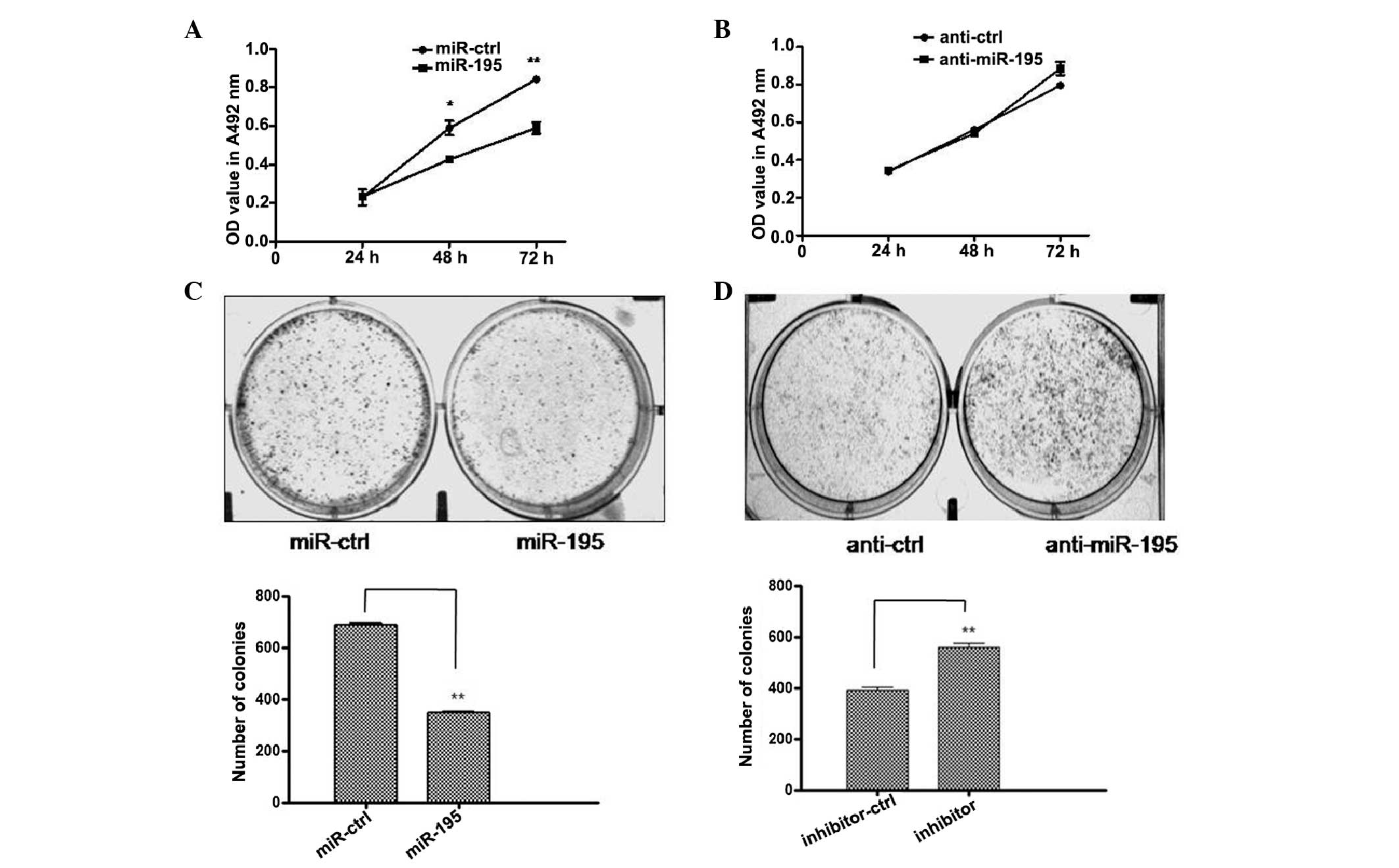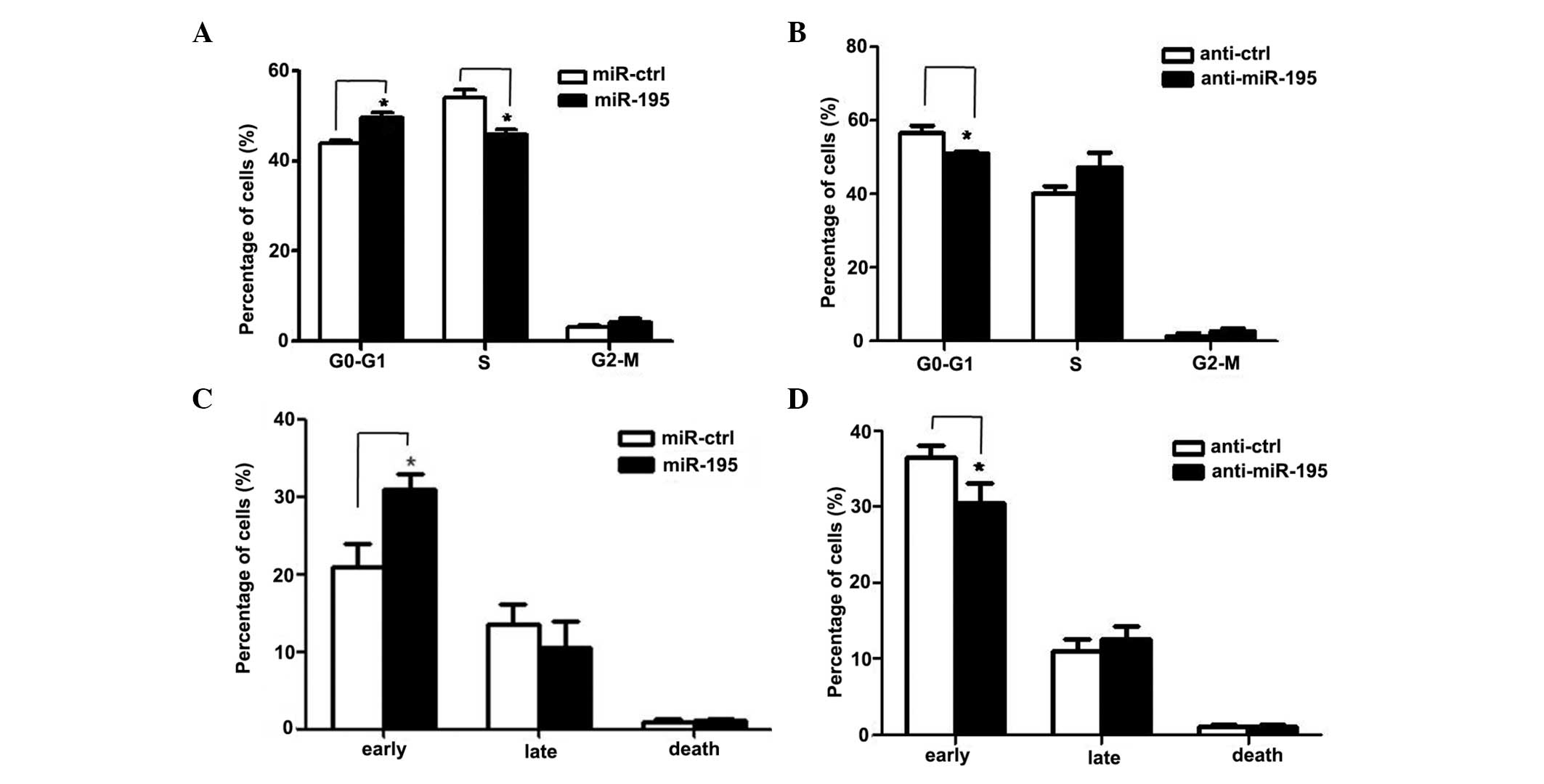|
1
|
Roberts LR: Sorafenib in liver cancer -
just the beginning. N Engl J Med. 359:420–422. 2008. View Article : Google Scholar : PubMed/NCBI
|
|
2
|
Yamashita T and Wang XW: Cancer stem cells
in the develop ment of liver cancer. J Clin Invest. 123:1911–1918.
2013. View
Article : Google Scholar
|
|
3
|
Nordenstedt H, White DL and El-Serag HB:
The changing pattern of epidemiology in hepatocellular carcinoma.
Dig Liver Dis. 42(Suppl 3): S206–S214. 2010. View Article : Google Scholar : PubMed/NCBI
|
|
4
|
McGlynn KA and London WT: The global
epidemiology of hepatocellular carcinoma: present and future. Clin
Liver Dis. 15:223–243. 2011. View Article : Google Scholar : PubMed/NCBI
|
|
5
|
Long XH, Mao JH, Peng AF, et al: Tumor
suppressive microRNA-424 inhibits osteosarcoma cell migration and
invasion via targeting fatty acid synthase. Exp Ther Med.
5:1048–1052. 2013.PubMed/NCBI
|
|
6
|
Hiyoshi Y, Kamohara H, Karashima R, et al:
MicroRNA-21 regulates the proliferation and invasion in esophageal
squamous cell carcinoma. Clin Cancer Res. 15:1915–1922. 2009.
View Article : Google Scholar : PubMed/NCBI
|
|
7
|
Moriyama T, Ohuchida K, Mizumoto K, et al:
MicroRNA-21 modulates biological functions of pancreatic cancer
cells including their proliferation, invasion, and chemoresistance.
Mol Cancer Ther. 8:1067–1074. 2009. View Article : Google Scholar
|
|
8
|
Chen D, Zhang Y, Wang J, et al:
MicroRNA-200c overexpression inhibits tumorigenicity and metastasis
of CD117+CD44+ ovarian cancer stem cells by
regulating epithelial-mesenchymal transition. J Ovarian Res.
6:502013. View Article : Google Scholar : PubMed/NCBI
|
|
9
|
Coulouarn C, Factor VM, Andersen JB,
Durkin ME and Thorgeirsson SS: Loss of miR-122 expression in liver
cancer correlates with suppression of the hepatic phenotype and
gain of metastatic properties. Oncogene. 28:3526–3536. 2009.
View Article : Google Scholar : PubMed/NCBI
|
|
10
|
Liang L, Wong CM, Ying Q, et al:
MicroRNA-125b suppressed human liver cancer cell proliferation and
metastasis by directly targeting oncogene LIN28B2. Hepatology.
52:1731–1740. 2010. View Article : Google Scholar : PubMed/NCBI
|
|
11
|
Liu AM, Poon RT and Luk JM: MicroRNA-375
targets Hippo-signaling effector YAP in liver cancer and inhibits
tumor properties. Biochem Biophys Res Comm. 394:623–627. 2010.
View Article : Google Scholar : PubMed/NCBI
|
|
12
|
Meng F, Henson R, Wehbe-Janek H, et al:
MicroRNA-21 regulates expression of the PTEN tumor suppressor gene
in human hepatocellular cancer. Gastroenterology. 133:647–658.
2007. View Article : Google Scholar : PubMed/NCBI
|
|
13
|
Su H, Yang JR, Xu T, et al: MicroRNA-101,
down-regulated in hepatocellular carcinoma, promotes apoptosis and
suppresses tumorigenicity. Cancer Res. 69:1135–1142. 2009.
View Article : Google Scholar : PubMed/NCBI
|
|
14
|
Zhang J, Luo N, Luo Y, et al: microRNA-150
inhibits human CD133-positive liver cancer stem cells through
negative regulation of the transcription factor c-Myb. Int J Oncol.
40:747–756. 2012.PubMed/NCBI
|
|
15
|
Ichimi T, Enokida H, Okuno Y, et al:
Identification of novel microRNA targets based on microRNA
signatures in bladder cancer. International Journal of Cancer.
125:345–352. 2009. View Article : Google Scholar : PubMed/NCBI
|
|
16
|
Soon PSH, Tacon LJ, Gill AJ, et al:
miR-195 and miR-483-5p identified as predictors of poor prognosis
in adrenocortical cancer. Clin Cancer Res. 15:7684–7692. 2009.
View Article : Google Scholar : PubMed/NCBI
|
|
17
|
Li D, Zhao Y, Liu C, et al: Analysis of
MiR-195 and MiR-497 expression, regulation and role in breast
cancer. Clin Cancer Res. 17:1722–1730. 2011. View Article : Google Scholar : PubMed/NCBI
|
|
18
|
Guo J, Miao Y, Xiao B, et al: Differential
expression of microRNA species in human gastric cancer versus
non-tumorous tissues. J Gastroenterol Hepatol. 24:652–657. 2009.
View Article : Google Scholar
|
|
19
|
Cadigan KM and Nusse R: Wnt signaling: a
common theme in animal development. Genes Dev. 11:3286–3305. 1997.
View Article : Google Scholar : PubMed/NCBI
|
|
20
|
Majid S, Dar AA, Saini S, et al:
MicroRNA-23b functions as a tumor suppressor by regulating Zeb1 in
bladder cancer. PloS One. 8:e676862013. View Article : Google Scholar : PubMed/NCBI
|
|
21
|
Volinia S, Calin GA, Liu CG, et al: A
microRNA expression signature of human solid tumors defines cancer
gene targets. Proc Natl Acad Sci USA. 103:2257–2261. 2006.
View Article : Google Scholar : PubMed/NCBI
|
|
22
|
Hui W, Yuntao L, Lun L, et al:
MicroRNA-195 inhibits the proliferation of human glioma cells by
directly targeting cyclin D1 and cyclin E1. PloS One. 8:e549322013.
View Article : Google Scholar : PubMed/NCBI
|
|
23
|
Liu L, Chen L, Xu Y, Li R and Du X:
microRNA-195 promotes apoptosis and suppresses tumorigenicity of
human colorectal cancer cells. Biochem Biophys Res Commun.
400:236–240. 2010. View Article : Google Scholar : PubMed/NCBI
|
|
24
|
Fatima S, Lee NP and Luk JM: Dickkopfs and
Wnt/β-catenin signalling in liver cancer. World J Clin Oncol.
2:311–325. 2011.
|
|
25
|
Calvisi DF, Wang C, Ho C, et al: Increased
lipogenesis, induced by AKT-mTORC1-RPS6 signaling, promotes
development of human hepatocellular carcinoma. Gastroenterology.
140:1071–1083. 2011. View Article : Google Scholar
|
|
26
|
Caja L, Sancho P, Bertran E, et al:
Overactivation of the MEK/ERK pathway in liver tumor cells confers
resistance to TGF-β-induced cell death through impairing
up-regulation of the NADPH oxidase NOX4. Cancer Res. 69:7595–7602.
2009.PubMed/NCBI
|
|
27
|
Chang Q, Zhang Y, Beezhold KJ, et al:
Sustained JNK1 activation is associated with altered histone H3
methylations in human liver cancer. J Hepatol. 50:323–333. 2009.
View Article : Google Scholar : PubMed/NCBI
|
|
28
|
He Y, Zhang H, Yin J, et al: IκBα gene
promoter polymorphisms are associated with hepatocarcinogenesis in
patients infected with hepatitis B virus genotype C.
Carcinogenesis. 30:1916–1922. 2009.
|
|
29
|
Whittaker S, Marais R and Zhu A: The role
of signaling pathways in the development and treatment of
hepatocellular carcinoma. Oncogene. 29:4989–5005. 2010. View Article : Google Scholar : PubMed/NCBI
|
|
30
|
Lu D, Zhao Y, Tawatao R, et al: Activation
of the Wnt signaling pathway in chronic lymphocytic leukemia. Proc
Natl Acad Sci USA. 101:3118–3123. 2004. View Article : Google Scholar : PubMed/NCBI
|
|
31
|
Ilyas M: Wnt signalling and the
mechanistic basis of tumour development. J Pathol. 205:130–144.
2005. View Article : Google Scholar : PubMed/NCBI
|
|
32
|
Nusse R and Varmus HE: Many tumors induced
by the mouse mammary tumor virus contain a provirus integrated in
the same region of the host genome. Cell. 31:99–109. 1982.
View Article : Google Scholar : PubMed/NCBI
|
|
33
|
Gougelet A and Colnot S: A Complex
Interplay between Wnt/β-Catenin Signalling and the Cell Cycle in
the Adult Liver. Int J Hepatol. 2012:8161252012.
|
|
34
|
He TC, Sparks AB, Rago C, et al:
Identification of c-MYC as a target of the APC pathway. Science.
281:1509–1512. 1998. View Article : Google Scholar : PubMed/NCBI
|
|
35
|
Shtutman M, Zhurinsky J, Simcha I, et al:
The cyclin D1 gene is a target of the β-catenin/LEF-1 pathway. Proc
Natl Acad Sci USA. 96:5522–5527. 1999.
|
|
36
|
Tetsu O and McCormick F: β-Catenin
regulates expression of cyclin D1 in colon carcinoma cells. Nature.
398:422–426. 1999.
|
|
37
|
Kaur P, Mani S, Cros MP, et al: Epigenetic
silencing of sFRP1 activates the canonical Wnt pathway and
contributes to increased cell growth and proliferation in
hepatocellular carcinoma. Tumor Biol. 33:325–336. 2012. View Article : Google Scholar : PubMed/NCBI
|
|
38
|
Guan CN, Chen XM, Lou HQ, et al: Clinical
Significance of Axin and β-catenin Protein Expression in Primary
Hepatocellular Carcinomas. Asian Pac J Cancer Prev. 13:677–681.
2012.
|
|
39
|
Loeppen S, Koehle C, Buchmann A and
Schwarz M: A β-catenin-dependent pathway regulates expression of
cytochrome P450 isoforms in mouse liver tumors. Carcinogenesis.
26:239–248. 2005.
|
|
40
|
Tien LT, Ito M, Nakao M, et al: Expression
of β-catenin in hepato-cellular carcinoma. World J Gastroenterol.
11:2398–2401. 2005.
|













